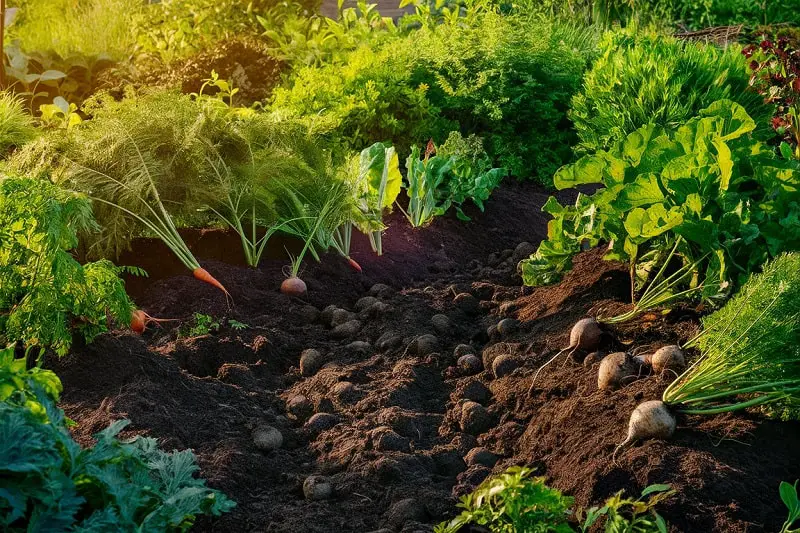Growing root vegetables can be incredibly rewarding, but achieving a bountiful harvest requires careful attention to one critical factor: soil quality. Whether you’re cultivating carrots, beets, radishes, or potatoes, the soil you choose will determine the success of your crops.
In this article, we will explore the key considerations for selecting the best soil for root vegetables, helping you to ensure that your garden produces the healthiest and most flavorful vegetables possible.
Understanding the Importance of Soil for Root Vegetables
Root vegetables grow underground, which means that the soil is their primary source of nutrients, water, and support. Unlike leafy greens or fruiting plants, root vegetables require soil that allows for easy penetration and expansion.
Poor soil conditions can lead to deformed roots, stunted growth, and even crop failure. Therefore, understanding the specific needs of your root vegetables is essential for selecting the right soil.
The Ideal Soil Composition for Root Vegetables
Sandy Loam Soil: The Gold Standard
When it comes to growing root vegetables, sandy loam soil is often considered the gold standard. This type of soil is a well-balanced mix of sand, silt, and clay, providing the perfect combination of drainage and moisture retention. The sandy texture allows roots to grow freely, while the loamy component retains enough moisture to keep the plants hydrated without becoming waterlogged.
pH Levels: Striking the Right Balance
Root vegetables generally prefer a slightly acidic to neutral soil pH, ranging from 6.0 to 7.0. Maintaining the correct pH level ensures that your plants can absorb essential nutrients like nitrogen, phosphorus, and potassium. Testing your soil’s pH level and making necessary adjustments with lime or sulfur can make a significant difference in the health and yield of your root vegetables.
Organic Matter: Feeding the Soil
Incorporating organic matter into your soil is crucial for promoting healthy root growth. Organic matter, such as compost, aged manure, or leaf mold, enriches the soil with nutrients and improves its structure. It also encourages beneficial microbial activity, which is essential for breaking down organic material and releasing nutrients to your plants. Aim to add 2-4 inches of organic matter to your soil before planting.
Common Soil Challenges and How to Overcome Them
Compacted Soil: A Root Vegetable’s Worst Enemy
Compacted soil is one of the most common issues faced by gardeners growing root vegetables. When soil is compacted, it becomes dense and hard, making it difficult for roots to penetrate and expand. This can lead to misshapen or stunted vegetables. To prevent soil compaction, avoid walking on your garden beds, and consider using raised beds or double-digging to loosen the soil.
Poor Drainage: The Dangers of Waterlogged Soil
Root vegetables require well-drained soil to thrive. Poor drainage can lead to waterlogged soil, which deprives roots of oxygen and encourages the growth of root rot. To improve drainage, consider incorporating sand or fine gravel into your soil, and ensure that your garden beds are slightly elevated to prevent water from pooling.
Heavy Clay Soil: Amending for Better Growth
Clay soil can be particularly challenging for root vegetables due to its heavy, dense nature. While clay soil is rich in nutrients, its poor drainage and compact structure can inhibit root growth. To amend clay soil, add plenty of organic matter and coarse sand to improve its texture and drainage. Gypsum can also be used to break up heavy clay.
Enhancing Soil Fertility for Root Vegetables
Balanced Fertilization: Nurturing Healthy Roots
Root vegetables require a balanced supply of nutrients to grow strong and healthy. A balanced fertilizer with a ratio of nitrogen, phosphorus, and potassium (N-P-K) that suits root crops is essential. Too much nitrogen can lead to lush foliage at the expense of root development, so it’s important to choose a fertilizer with a lower nitrogen content and higher phosphorus and potassium levels.
Crop Rotation: Preventing Soil Depletion
Crop rotation is a time-tested method for maintaining soil fertility and preventing the buildup of pests and diseases. By rotating your root vegetables with other plant families each season, you can prevent soil depletion and reduce the risk of soil-borne diseases. Consider following your root crops with legumes, which naturally fix nitrogen in the soil, enhancing its fertility for future planting.
Mulching: Conserving Moisture and Suppressing Weeds
Mulching is a valuable practice for growing root vegetables. Applying a layer of organic mulch such as straw, leaves, or grass clippings helps to conserve soil moisture, regulate temperature, and suppress weed growth. Mulch also gradually breaks down, adding organic matter to the soil. Ensure that the mulch is not too thick, as this can prevent air and water from reaching the soil.
Soil Testing: The Key to Optimal Growth
Regular Soil Testing: Knowing Your Soil’s Needs
Regular soil testing is essential for understanding your soil’s nutrient levels, pH, and overall health. By testing your soil before planting, you can make informed decisions about which amendments and fertilizers are necessary to optimize growth. Soil testing kits are widely available and easy to use, or you can send a sample to a local extension service for more detailed analysis.
Conclusion: Setting the Foundation for a Successful Harvest
Choosing the best soil for root vegetables is the foundation of a successful garden. By understanding the unique needs of your crops and selecting soil that provides the right balance of texture, pH, and nutrients, you can ensure a bountiful and healthy harvest.
Whether you’re a novice gardener or a seasoned pro, investing time and effort into preparing the perfect soil will pay off in the form of delicious, homegrown root vegetables.
Start with the right soil, and you’ll be well on your way to enjoying a garden filled with vibrant, flavorful produce.
